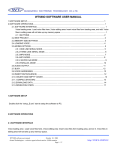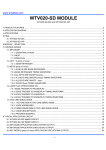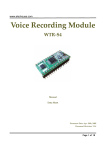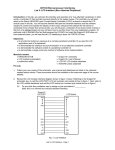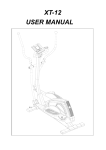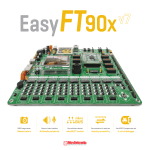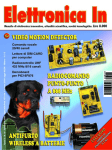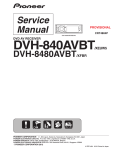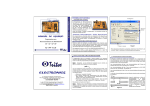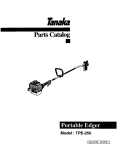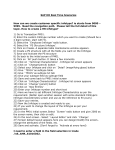Download WT588D-U user manual_VoiceLand
Transcript
The Instructions of WT588D-U Voice Module
CATALOG UE
WT588D-U User manual
www.voiceland.co.kr
1、 Product Features ............................................................................................................... 1
2、 Functional Description ........................................................................... 错 误 ! 未 定 义 书 签 。
3、 Application scopes ............................................................................................................ 4
4、 Application Block diagram .................................................................................................. 4
5、 Pin Package Fig. ............................................................................................................... 5
6、 Electrical Parameters......................................................................................................... 6
7、 The Absolute Limits of The Environment Parameters............................................................ 7
8、 Control Mode .................................................................................................................... 7
8.1、 Button Control Mode ................................................................................................. 7
8.1.1、 Tigger Impulse Repetition ................................................................................. 7
8.1.2、 Trigger Impluse Without Repetition .................................................................... 8
8.1.3、 Recycled Level ................................................................................................. 8
8.1.4、 Nocycle Level .................................................................................................. 8
8.1.5、 Non-Maintained Cycle Level .............................................................................. 9
8.1.6、 Play / Stop ....................................................................................................... 9
8.1.7、 Non-Cycle for The Next Tone............................................................................. 9
8.1.8、 Non-Cycle for The Last Tone ........................................................................... 10
8.1.9、 Recycle for The Next Tone .............................................................................. 10
8.1.10、 Recycle for The Last Tone ............................................................................. 10
8.1.11、 Pause .......................................................................................................... 11
8.1.12、 Stop ............................................................................................................. 11
8.2、 One-Wire Serial Port Control Mode ......................................................................... 11
8.2.1、 Port Allocation Table ....................................................................................... 11
8.2.2、 Order and Speech Cording .............................................................................. 12
8.2.3、 Voice Address Correspondence ....................................................................... 12
8.2.4、 Control Time Sequence Chart.......................................................................... 12
8.2.5、 The Example of 1-Wire Serial Port Control Time Sequence ............................... 13
8.2.6、 Models of Procedure ....................................................................................... 13
8.3、 Three-Wire Serial Control mode ............................................................................... 14
8.3.1、 Port Allocation Methods .................................................................................. 14
8.3.2、 Voice and Command Code Corresponding to Table ........................................... 14
8.3.3、 Voice Address Corresponds ............................................................................ 14
8.3.4、 Three-Wire Serial Port Control Time Sequence................................................. 15
8.3.5、 Modles of Procedure ....................................................................................... 15
9、 Typical Application Circuit ................................................................................................ 16
9.1、 Typical Application Circuit of Key to Control( PWM output, 5V Supply) ................... 16
9.2、 Typical Application Circuit of Keys to Control( PWM output, 3.3V Supply) .............. 16
9.3、 Typical Application Circuit of Keys to Control( DAC output) .................................... 17
9.4、 Typical Application of Frst-line Serial Cntrol Circuit (PWM Output) ........................... 17
9.5、 Typical Application of First-line Serial Control Circuit( DAC Output) ........................ 17
9.6、 0ne-Wire Serial Port MCU5V Power/ Module 3.3V Power Supply Application circuit (PWM
output) ........................................................................................................................... 18
-第 2 页 -
WT588D-U User manual
www.voiceland.co.kr
9.7、 Three-Wire Serial Control of Typical Application circuit (PWM output) ........................ 19
9.8、 Three-wire serial control of a typical application circuit (DACoutput) .......................... 19
9.9、 Three-wire serial MCU5V power / module 3.3V power supply application circuit (PWM
output) MCU5V ............................................................................................................... 19
10、 Control procedures ........................................................................................................ 20
10.1、 One-wire serial control of assembler ...................................................................... 20
10.2、 One-wire serial control of C-voice procedures ......................................................... 21
10.3、 Three-wire serial control of assembler .................................................................... 23
10.4、 Three-wire serial control of C-voice procedures ...................................................... 24
11、 Package size Figure ....................................................................................................... 26
12、 Sources of information ................................................................................................... 27
13 、 The corresponding relations among SPI-Flash memory capacity, sample rates and time
SPI-Flash ............................................................................................................................. 27
14、 Instruction edition and history records ........................................................................... 28
1、 Product features
¾
Package of 28 pins module, which can be replaced memory for gainting different lengths of storage
time.
¾
Support SPI-Flash, which ‘s capacity is 2M bit ~ 32M (Note: 1byte = 8bit)
¾
WT588D-20SS voice used as a control core chip.
¾
Embedded human voice processor, feel very natural and sweet.
¾
Good audio quality output for 13Bit/DA converter and 12Bit/PWM processing of audio.
¾
Support for loading 6K ~ 22KHz audio sampling rate.
¾
PWM output can directly promote 0.5W/8Ω speakers and plenty of current.
¾
Support DAC / PWM output
¾
Support for loading WAV audio format.
¾
Support key control mode, one-wire serial control mode, three-wire serial control mode.
¾
A variety of IO trigger ways can be seted to in button control mode.
¾
The way of BUSY signal output can be set in a random manner.
¾
Loading no more than 500 segments voice for editing.
¾
Address bit is controled by 220 segments voice, but a single address bit just can load up to 128.
¾
Voice player to enter the sleep mode to stop immediately.
¾
It is simple interface and convenient because of using WT588D Voice Chip that benefited to exert its
functions.
¾
A lot of operations can be finished in software. Such as setup control mode, inserting voice,
compositing voice, calling voice, etc.
¾
Free to insert mute, mute time range 10ms ~ 25min.
¾
Support online USB download / offline USB download. What’s more, it also can download data to
SPI-Flash even if WT588D-U are working.
¾
Operating voltage: DC2.8V ~ 5.5V.
-第 3 页 -
WT588D-U User manual
¾
dormant current less than 10uA
¾
Powerful anti-jamming. Widely used in the industrial field.
www.voiceland.co.kr
2、Functional Description
Button control mode is flexible to trigger and free to set any button to re-trigger .There are 15 trigger ways.
Including trigger Impulse Repetition , trigger pluse Without Repetition , invalidation keys, no cycle Level ,
Recycled Level , Non-Maintained Cycle Level, Non-Cycle for The Last One ,Non-Cycle for The Next One ,
Cycle for The Last One , Cycle for The Next One, Volume +, Volume -, play / pause, stop, play / stop, etc .
One-wire serial control mode and three-wire serial control mode, not only can control voice play, stop,
loop play and volume size by the MCU, but also can direct triggering any voice in address bit from 0 to
219.
3、application scopes
Widely range of applications. Almost related to all the voice places, such as Stop devices, annunciators ,
reminder, alarm clock, learning machine, intelligent home appliances, therapeutic equipment, electronic
toys, telecommunications, reversing radar and a variety of automatic control devices, etc. Technology meet
up to the requirements of industries application.
4、Application block diagram
BUSY output
Control port
WT588D-U module
Voice output
-第 4 页 -
USB download
WT588D-U User manual
www.voiceland.co.kr
5、Package pins diagram
1
2
3
4
5
6
7
8
9
10
11
12
13
14
NC
NC
NC
NC
NC
NC
RESET
DAC
PW M +
PW M P14
P13
P16
GND
VD D-USB
D+
DGN D
NC
NC
VDD
BUSY
VCC
P00
P01
P02
P03
P15
28
27
26
25
24
23
22
21
20
19
18
17
16
15
Pin Description
Package
Pins mark
Brief
Functional Description
1
NC
NC
blank
2
NC
NC
blank
3
NC
NC
blank
4
NC
NC
blank
5
NC
NC
blank
6
NC
NC
blank
7
RESET
RESET
Reset pin
8
DAC
DAC
DAC Audio output pin, ne ed an external amplifier to drive
pins
speaker
9
PWM+
PWM+
PWM+ Audio output pin, which can
directly drive
speaker with the PWM10
PWM-
PWM-
PWM- Audio output pin, which can
directly drive
speaker with the PWM+
11
P14
SPI-FLASH_DI
use for external
download manager
12
P13
SPI-FLASH_DO
use for external
download manager
13
P16
SPI-FLASH_CLK
use for external
download manager
14
GND
GND
GND
15
P15
SPI-FLASH_CS
use for external
16
P03
K4/CLK/DATA
Button / three-wire clock / one-wire data input pin
17
P02
K3/CS
Button / three-wire chip input pin
18
P01
K2/DATA
Button / three-wire data input pin
19
P00
K1
Button
20
VCC
VCC
Analog power supply input pin
-第 5 页 -
download manager
www.voiceland.co.kr
WT588D-U User manual
21
BUSY
BUSY
busy signal output pin
22
VDD
VDD
Data power supply input pin
23
NC
NC
blank
24
NC
NC
blank
25
GND
GND
USB
GND
26
D-
USB_DATA-
USB
data
27
D+
USB_DATA+
USB
data
28
VDD_USB
VDD_USB
USB
power
positive
Note:Pin25,26,27,28 use to download for other USB slot.
6、electrical parameters
V DD − V SS = 4.5V, TA = 25°C, No load
Parameter
marker
Environmental conditions
min
Operating voltage
VDD
F s y s =8MHz
2.8
Operating Current
IOP1
No load
-
Stop current
IDD2
No load
Dormancy
IOP2
Low-voltage input
Typical
Max
Units
5.5
V
4.5
5.5
mA
-
1
2
uA
No load
-
650
VIL
All pin input
VSS
-
0.3V D D
V
high-voltage input
VIH
All pin input
0.7V D D
-
VDD
V
Input currentBP1、
IIN1
V I N =0V
-5
-9
-14
uA
-15
-30
-45
uA
uA
current-mode
BP2、 RESET
Input currentBP1、
Pull-up resistance=500KΩ
IIN2
BP2、 RESET
output
current
( BP0)
output
current
( BP1)
output
current
PWM+/PWM-
V I N =0V
Pull-up resistance=150KΩ
IOL
VDD=3V, VOUT=0.4V
8
12
-
mA
IOH
VDD=3V, VOUT=2.6V
-4
-6
-
mA
IOL
VDD=4.5V, VOUT=1.0V
-
25
-
mA
IOH
VDD=4.5V, VOUT=2.6V
-
-12
-
mA
IOL
VDD=3V, VOUT=0.4V
4
10
-
mA
IOH
VDD=3V, VOUT=2.6V
-4
-6
-
mA
IOL1
RL=8Ω
+200
-
-
mA
IOH1
【 PWM+ 】 -- 【 RL 】 --
-200
-
-
mA
-2.4
-3.0
-3.6
mA
-4.0
-5.0
-6.0
【 PWM-】
DAC Max current
IDAC
RL=100Ω
-第 6 页 -
www.voiceland.co.kr
WT588D-U User manual
Pull-up
resistor
RPL
75
150
225
test
7、Absolute limits of the environment parameters
parameters
marker
Environmental
rating
units
-
-0.3~ +7.0
V
conditions
power
VDD
Input voltage
VIN
input
V S S -0.3~ V D D +0.3
V
Storage
TSTG
-
-55~ +150
°C
TOPR
-
-40~ +85
°C
—
VSS
temperature
Used temperature
8、control mode
8.1、Buttons Control Mode
Pins can directly trigger a function of chip to work. Each pin of the trigger can be set individually.
Shockproof time of this mode time is about 10ms. There are 15 trigger ways. Including trigger Impulse
Repetition , trigger pluse Without Repetition , invalidation keys, no cycle Level , Recycled Level ,
Non-Maintained Cycle Level, Non-Cycle for The Last Tone ,Non-Cycle for The Next Tone , Cycle for The
Last Tone , Cycle for The Next Tone, Volume +, Volume -, play / pause, stop, play / stop, etc. see the
following trigger timing diagram. For more details, see the following chart:
8.1.1、Trigger Impulse Repetition
Pluse
Voice
Busy signal
Note: Negative trigger pulse. When the I / O port inspects the falling edge (for example, the I / O port
click short-circuit to GND),
Voice will be broadcast .If do that again when the Voice are still playing, the
-第 7 页 -
WT588D-U User manual
www.voiceland.co.kr
voice will be interrupted and replay. Therefore, it will be replay as long as has falling edge signal.
8.1.2、Trigger Impluse Without Repetition
Pluse
Voice
Busy signal
Note: Negative trigger pulse. When the I / O port inspects the falling edge (for example, the I / O port
click short-circuit to GND), Voice will be broadcast. If do that again when the voice are still playing , the
voice will not be interrupted and continue to broadcast. To be valid unless the voice at an end and inspects
the falling edge.
8.1.3、Recycled Level
level
Voice
Adress1
Address 1
Address 1
Busy signal
Note: High level stops when the I / O port is low and keep play. Continue to keep a low level even if the
first time is over. It will go along replay until change into high level. Low level has sound. High level
hasn’t.
8.1.4、No Cycle Level
level
Voice
Address 1
Address 1
Busy signal
Note: Trigger level. High level stops when the I / O port is low and keep play. I will be not Continue to
play even if the first time is over and keep a low level. The voice just play one time after being triggered.
-第 8 页 -
WT588D-U User manual
www.voiceland.co.kr
If you need to replay, please make the I / O port at high level, and then pull low. Finally, keep it at low
level .The end.
8.1.5、Non-Maintained Cycle Level
Level
Voice
Address 1
Address 1
Address 1
Busy signal
Note: Negative Pulse /trigger Level. When the I / O port at low level and keep playing, at the same time,
high level don’t stop until the voice is over. When the end of the first time. If keep at the low level, it will
continue to repeat .If not, when finish it will stop automatically.
8.1.6、Play/Stop
Pluse
Voice
Busy signal
Note: Negative trigger pulse. Negative pulse starts to play when the next one stop. Whether the voice is in
play or not must in accordance with this regulation.
8.1.7、Non-Cycle for The Next Tone
Pluse
Voice
Address 1
Address 2
Address N
Busy signal
Note: Negative trigger pulse. Trigger with a button to play a sound. A pulse plays a piece, the next pulse
plays the next piece .It doesn’t stop until the last piece is finished. Repeat the same operation. Can only
-第 9 页 -
WT588D-U User manual
www.voiceland.co.kr
play to the last.
8.1.8、Non-Cycle for The Last Tone
Pluse
Voice
Address N
Address N-1
Address 0
Busy signal
Note: Negative trigger pulse. Trigger with a button to play a sound. A pulse plays a piece, the next pulse
plays the last piece. No longer trigger forward when the front voice is over. Repeat the operation, can only
play to the last.
8.1.9、Cycle for The Next Tone
Pluse
Voice
Address 1
Address 2
Address N
Address 0
Busy signal
Note: Negative trigger pulse. Trigger with a button to play a sound. A pulse plays a piece , the next pulse
plays the next piece. Repeat the operation. It will start again from the first piece when the last shows off.
Loop continuously.
8.1.10、Cycle for The Last Tone
Pluse
Voice
Address N-1
Address N-2
Address 0
Busy signal
-第 10 页 -
Address N
www.voiceland.co.kr
WT588D-U User manual
Note: Negative trigger pulse. Trigger with a button to play a sound. A pulse plays a piece, the next pulse
plays the last piece. Repeat the operation. It will start again from the last piece when the front shows off.
Loop continuously.
8.1.11、Pause
Pluse
Voice
Paused
Busy signal
Note: Negative trigger pulse. The first pulse voice is playing but in a suspended state. The second pulse
still working, which triggers the suspension of the voice. BUSY remain in this state.
8.1.12、Stop
Pluse
voice
Busy signal
Note: Negative trigger pulse. Stopped the voice, which is playing . Trigger once again invalidly when the
voice is stopped.
8.2、One-Wire Serial Port Control Mode
Send data through a data line. One-wire serial port can control voice play, stop, volume adjustment and
directly trigger, etc. P00 ~ P02 I/O port can select screen or any trigger mode.
8.2.1、Port Allocation Table
I/O 口
P00
P01
P02
-第 11 页 -
P03
WT588D-U User manual
function
Key-press
Key-pressK
K1
2
Key-pressK3
www.voiceland.co.kr
DATA
8.2.2、Order and Speech Cording
Commend
Functions
Descriptions
volume
8 volume can be adjusted, E0H is minimum, E7H is the largest volume
adjustment
when working or standby.
F2H
Cycle play
the current voice addresses can be recycled When working.
FEH
Stop playing
Voice command to stop playing
code
E0H~ E7H
8.2.3、Voice Address Correspondence
Data( hex)
functions
00H
Play the zero piece voice
01H
Play the first piece voice
02H
Play the second piece voice
……
……
D9H
Play the 217th piece voice
DAH
Play the 218th piece voice
DBH
Play the 219th piece voice
8.2.4、Control Time Sequence Chart
One-wire serial port only through a data communication line control time sequence. According to different
duty cycle of levels represent different data bit. Firstly, data signals is drawned down 5ms, and then send
data .The duty cycle of High level and low level 1:3 means data bit 0, if 3:1 means data bit 1, high in the
former. Data signals send from low to high. When Send data, you just send address datum directly can
trigger to play voice without sending command code and instruction. D0 ~ D7 means an address or
command data. 00H ~ DBH of data send address order. E0H ~ E7H is volume adjustment order.F2H is
Loop orders. FEH orders to stop playing. Details of time sequence in the following diagram:
-第 12 页 -
www.voiceland.co.kr
WT588D-U User manual
DATA
5m s
D0
D1
D2
D3
D4
D5
D6
D7
20m s
VOICE
BUSY
Description: WT588D-U can not enter dormant state under the one-wire serial interface. Therefore,
using with caution when battery-powered .DATA is a communications line for one-wire serial interface,
WT588D-U voice module begins to send data signals after current is switched on and wait 17ms.BUSY
voice for the busy signal output. Wait for 20ms Data after sent successfully. And BUSY output will be to
respond. Details of data bit duty cycle in the following chart:
High level: Low level=1: 3 means 0
High level: Low level =3: 1 means 1
8.2.5、The Example of 1-Wire Serial Port Control Time Sequence
For example, Send time sequence of data 9CH chart in one-Wire Serial Port Control mode is show in
figure:
5m s
DATA
0
0
1
1
1
0
0
1
20m s
VOICE
BUSY
8.2.6、Models of Procedure
Master SCM: PIC16F54, Clock frequency :4MHz
Send one-line (unsigned char addr)
{
sda=0;
delay1ms(5);
/* Data signals at low
level 5ms */
for(i=0;i<8;i++)
{
sda=1;
if(addr & 1)
-第 13 页 -
www.voiceland.co.kr
WT588D-U User manual
{ delay1us(600);
/* High level: Low level =600us: 200us, means data=1 */
sda=0;
delay1us(200);}
else{
delay1us(600);
/* High level: Low level =200us: 600us, means data=0 */
sda=0;
delay1us(200); }
addr>>=1; }
sda=1; }
8.3、Three-Wire Serial Control mode
CS, DATA and CLK are composed of Three-Wire Serial Control mode .Time sequence according to
SPI communication. Three-wire serial port can control command control and voice broadcast. All
key-presses are not valid in the three-wire serial mode.
8.3.1、Port Allocation Methods
I/O 口
P00
P01
P02
P03
Functions
---
DATA
CS
CLK
8.3.2、Voice and Command Code Corresponding to Table
Comman
Functions
Description
Volume
8 volume can be adjusted, E0H is minimum, E7H is the largest volume
E7H
adjustment
when working or standby.
F2H
Cycle play
The current voice addresses can be recycled When working.
FEH
Stop playing
Voice command to stop playing
d Code
E0H
~
8.3.3、Voice Address Corresponds
data( hex)
functions
00H
Play the zero piece voice
01H
Play the first piece voice
02H
Play the second piece voice
-第 14 页 -
www.voiceland.co.kr
WT588D-U User manual
……
……
D9H
Play the 217th piece voice
DAH
Play the 218th piece voice
DBH
Play the 219th piece voice
8.3.4、Three-Wire Serial Port Control Time Sequence
CS, CLK and DATA pins are composed of Three-Wire Serial Control mode .Time sequence follows to SPI
communication. CS downs to 5ms in order to wake-up WT588D-U voice module. Low bit receives data at
the rising edge of CLK in the first place. Clock cycles between the range of 100us ~ 2ms, recommended
300us. The BUSY voice outputs in response to the successful reception of data. Data signals send from low
to high. When Send data, you just send address datum directly can trigger to play voice without sending
command code and instruction. D0 ~ D7 means an address or command data. 00H ~ DBH of data send
address order. E0H ~ E7H is volume adjustment order.F2H is Loop orders. FEH orders to stop play.
Details of time sequence in the following diagram:
5m s
CS
300us
CLK
DATA
D0
D1
D2
D3
D4
D5
D6
VOICE
D7
20m s
BUSY
Description: WT588D-U voice module begins to send data signals after current is switched on and wairt
17ms.
8.3.5、Models of Procedure
( Master SCM PIC16F54, System frequency 4MHz)
Send threelines(unsigned char addr)
{ cs=0;
delay1ms(5);
/* Chip select signal keep low level 2ms */
for(i=0;i<8;i++)
{
scl=0;
if(addr & 1)sda=1;
else sda=0;
addr>>=1;
-第 15 页 -
WT588D-U User manual
delay1us(300);
www.voiceland.co.kr
/* Clock cycle 300us */
scl=1;
delay1us(300);
}
cs=1;}
9、Typical Application Circuit
9.1、Typical Application Circuit of Key to Control(PWM output,5V Supply)
RESET
SPEAKER
1
2
3
4
5
6
7
8
9
10
11
12
13
14
NC
NC
NC
NC
NC
NC
RESET
D AC
PW M +
PW M P14
P13
P16
GN D
VD D -USB
D+
DGN D
NC
NC
VD D
BUSY
VCC
P00
P01
P02
P03
P15
+5V
28
27
26
25
24
23
22
21
20
19
18
17
16
15
R1
470
LED
K1
K2
K3
K4
W T588D -U
9.2、Typical Application Circuit of Keys to Control(PWM output,3.3V Supply )
+3.3V
RESET
SPEAKER
1
2
3
4
5
6
7
8
9
10
11
12
13
14
NC
NC
NC
NC
NC
NC
RESET
DAC
PW M +
PW M P14
P13
P16
GN D
VDD -USB
D+
DGN D
NC
NC
VD D
BUSY
VCC
P00
P01
P02
P03
P15
W T588D -U
28
27
26
25
24
23
22
21
20
19
18
17
16
15
R1
470
LED
K1
K2
K3
K4
-第 16 页 -
www.voiceland.co.kr
WT588D-U User manual
9.3 、 Typical Application Circuit of Keys to Control ( DAC output )
C7
6
1
250uF
5
1uF
LM 386
C10
3
0.05uF
SPEAKER
C8
2
8
C11
7
10KΩ
4
R7
C6
C9
10Ω
+5V
RESET
VCC
10uF
104
10uF
1
2
3
4
5
6
7
8
9
10
R2 11
12
1.2K 13
14
NC
NC
NC
NC
NC
NC
RESET
DAC
PW M +
PW M P14
P13
P16
GN D
VD D-USB
D+
DGND
NC
NC
VDD
BUSY
VCC
P00
P01
P02
P03
P15
W T588D-U
Note:
28
27
26
25
24
23
22
21
20
19
18
17
16
15
D1
R1
4007
470
LED
D2
4007
K1
K2
K3
K4
DAC output port together with the ground, which connect with a 1.2K resistor and capacitor 104.
when use DAC output way, and then the audio signal re-entering amplifier part, as circuit diagram of R2,
R6 shown.
9.4、Typical Application of one-line Serial Control Circuit (PWM out)
SPEAKER
1
2
3
4
5
6
7
8
9
10
11
12
13
14
NC
NC
NC
NC
NC
NC
RESET
DAC
PW M +
PW M P14
P13
P16
GN D
VD D -USB
D+
DGN D
NC
NC
VD D
BUSY
VCC
P00
P01
P02
P03
P15
28
27
26
25
24
23
22
21
20
19
18
17
16
15
+5V
R1
470
LED
+5V
D ATA
M CU
W T588D -U
9.5、Typical Application of First-line Serial Control Circuit(DAC Output)
-第 17 页 -
www.voiceland.co.kr
WT588D-U User manual
C7
VCC
10uF
6
1
2
8
C11
250uF
5
1uF
LM 386
C10
3
0.05uF
SPEAKER
C8
7
4
R7
10KΩ
C6
C9
10Ω
104
10uF
1
2
3
4
5
6
7
8
9
10
R2 11
12
1.2K 13
14
NC
NC
NC
NC
NC
NC
RESET
D AC
PW M +
PW M P14
P13
P16
GN D
VD D -USB
D+
DGN D
NC
NC
VD D
BUSY
VCC
P00
P01
P02
P03
P15
28
27
26
25
24
23
22
21
20
19
18
17
16
15
+5V
R1
470
LED
+5V
D ATA
M CU
W T588D -U
Note:
DAC output port together with the land , which connect with a 1.2K resistor and capacitor 104.
when use DAC output way, and then the audio signal re-entering amplifier part, as circuit diagram of R2,
R6 shown.
9.6 、 0ne-Wire Serial Port MCU5V Power/ Module 3.3V Power Supply
Application circuit (PWM output)
+3.3V
SPEAKER
1
2
3
4
5
6
7
8
9
10
11
12
13
14
NC
NC
NC
NC
NC
NC
RESET
D AC
PW M +
PW M P14
P13
P16
GN D
VD D -USB
D+
DGN D
NC
NC
VD D
BUSY
VCC
P00
P01
P02
P03
P15
28
R1
27
26
25
24
23
22
21
20
19
D ATA
18 R2
CS
17 R3
CLK
16 R4
15 470Ω×3
470
LED
+5V
M CU
W T588D -U
-第 18 页 -
www.voiceland.co.kr
WT588D-U User manual
9.7、Three-Wire Serial Control of Typical Application circuit (PWM output)
1
2
3
4
5
6
7
8
9
10
11
12
13
14
SPEAKER
NC
NC
NC
NC
NC
NC
RESET
D AC
PW M +
PW M P14
P13
P16
GN D
VD D -USB
D+
DGN D
NC
NC
VD D
BUSY
VCC
P00
P01
P02
P03
P15
+5V
28
27
26
25
24
23
22
21
20
19
18
17
16
15
R1
470
LED
+5V
DATA
CS
CLK
M CU
W T588D -U
9.8、Three-wire serial control of a typical application circuit (DAC output)
C7
VCC
10uF
6
8
C11
250uF
5
SPEAKER
R7
10Ω
C8
2
1uF
LM 386
C10
0.05uF
1
3
7
4
C9
10uF
10KΩ
C6
104
1
2
3
4
5
6
7
8
9
10
R2 11
12
1.2K 13
14
NC
NC
NC
NC
NC
NC
RESET
D AC
PW M +
PW M P14
P13
P16
GN D
VD D -USB
D+
DGN D
NC
NC
VDD
BUSY
VCC
P00
P01
P02
P03
P15
28
27
26
25
24
23
22
21
20
19
18
17
16
15
+5V
R1
470
LED
+5V
DATA
CS
CLK
M CU
W T588D -U
Note:
DAC output port together with the ground, which connect with a 1.2K resistor and capacitor 104.
When use DAC output way, and then the audio signal re-entering amplifier part, as circuit diagram of R2,
R6 shown.
9.9、 Three-wire serial MCU5V power / module 3.3V power supply application circuit (PWM output)
-第 19 页 -
www.voiceland.co.kr
WT588D-U User manual
+3.3V
SPEAKER
1
2
3
4
5
6
7
8
9
10
11
12
13
14
NC
NC
NC
NC
NC
NC
RESET
DAC
PW M +
PW M P14
P13
P16
GND
VDD -USB
D+
DGND
NC
NC
VDD
BUSY
VCC
P00
P01
P02
P03
P15
28
27
26
25
24
23
22
21
20
19
18
17
16
15
R1
470
LED
+5V
R2 470 DATA
M CU
W T588D-U
MCU5V
10、Control procedures
10.1、One-wire serial control of assembler
Description: This procedure is test program. Please change the IO port of MCU according to Practical
application.
ORG 0000H
KEY EQU P1.1
;
Button pin
SDA EQU P3.0
;
Data pin
;
A temporary address for Code value
DAIFAZHI EQU 50H
MOV DAIFAZHI,#0H;
Code made the initial value of 0
MOV R5,#8
8-bit Circulation of Fat Code
;
MAIN:
JB KEY,MAIN
MOV R6,#20
;Delay 20MS
LCALL DELAY1MS
JB KEY,MAIN
; Buffeting button to judgment
JNB KEY,$
;Wait for button release
LCALL one-line
; Transfer one-wire fat code Subroutine
INC DAIFAZHI
; Code value plus 1 fat
MOV A,DAIFAZHI
CJNE A,#220,XX2 ;Whether reach max 220 of the Voice paragraph or not
XX2: JC XX3
MOV DAIFAZHI,#0H
XX3: LJMP MAIN
-第 20 页 -
WT588D-U User manual
One-line:
www.voiceland.co.kr
;//// one-wire fat code Subroutine
CLR SDA
MOV R6,#5
; Delay 5MS
LCALL DELAY1MS
MOV A, DAIFAZHI
LOOP:
SETB SDA
RRC A
JNC DIDIANPIN
; High level pulse
High: Low=3:1
LCALL DELAY200US
LCALL DELAY200US
LCALL DELAY200US
CLR
SDA
LCALL DELAY200US
LJMP LOOP1
DIDIANPIN
; Low level pulse
High: Low =1:3
LCALL DELAY200US
CLR SDA
LCALL DELAY200US
LCALL DELAY200US
LCALL DELAY200US
LOOP1:
DJNZ R5,LOOP
MOV R5,#08H
SETB SDA
RET
DELAY200US:
MOV R6,#100
; Delay Subroutine 400US
DJNZ R6,$
RET
DELAY1MS:
; Delay Subroutine 1ms, help R6 evaluate, Modified to extend the
time
L1:
MOV R7,#248
DJNZ R7,$
DJNZ R6,L1
RET
END
10.2、 One-wire serial control of C-voice procedures
Description: This procedure is test program.Please change the IO port of MCU according to Practical
application.
#include <at89x2051.H>
sbit KEY=P1^1; /* The 2 nd of P1 port is P1_1 */
-第 21 页 -
WT588D-U User manual
sbit SDA=P3^0; /* The 4 th of P3 port is P3_0 P3_0 */
void delay1ms(unsigned char count) //1MS delay time Subroutine
{
unsigned char i,j,k;
for(k=count;k>0;k--)
for(i=2;i>0;i--)
for(j=248;j>0;j--);
}
void delay100us(unsigned char count)
//100US Delay time Subroutine
{ unsigned char i;
unsigned char j;
for(i=count;i>0;i--)
for(j=50;j>0;j--);
}
Send_oneline(unsigned char addr)
{
unsigned char i;
SDA=0;
delay1ms(5);
/* delay 5ms */
for(i=0;i<8;i++)
{SDA=1;
if(addr & 1)
{delay100us(6);
/* 600us */
SDA=0;
delay100us(2);
/* 200us */
}
else {
delay100us(2);
/* 200us */
SDA=0;
delay100us(6);
/* 600us */
}
addr>>=1; }
SDA=1;
}
main()
{unsigned char FD=0;
P3=0XFF;
while(1)
{
-第 22 页 -
www.voiceland.co.kr
WT588D-U User manual
www.voiceland.co.kr
if(KEY==0)
{
delay1ms(10);
if(KEY==0)
// Increase Code value of fat by button P1.1.
{
Send online (FD);
FD++;
if(FD==220) // 0ne-wire Serial port, the voice segment up to a maximum of 220
{
FD=0;
}
while(KEY==0);
// Waiting for button release in order to avoid Miscarriage of justice
}
}
}
10.3、Three-wire serial control of assembler
Description: This procedure is test program.Please change the IO port of MCU according to Practical
application.
ORG 0000H
KEY EQU P1.1
; Button pin
CS
;CS trigger pin
EQU P3.1
SCL EQU P3.2
;Clock pin
SDA EQU P3.0
;Data pin
DAIFAZHI EQU 50H;A temporary address for Code value
MOV DAIFAZHI,#0H;Code made the initial value of 0
MOV R5,#8
;Code made the initial value of 0
MAIN:
JB KEY,MAIN
MOV R6,#20
;Dalay time 20MS
LCALL DELAY1MS
JB KEY,MAIN
JNB KEY,$
; Buffeting button to judgment
; Wait for button release
LCALL THREE_LINE; Transfer three-wire fat code Subroutine
INC DAIFAZHI
; Code value plus 1 fat
MOV A,DAIFAZHI
CJNE A,#220,XX2 ; Whether reach max 220 of the Voice paragraph or not
XX2: JC XX3
MOV DAIFAZHI,#0H
-第 23 页 -
WT588D-U User manual
www.voiceland.co.kr
XX3: LJMP MAIN
THREE_LINE:
;//// three-wire fat code Subroutine
CLR CS
MOV R6,#5
; Dalay time 5MS
LCALL DELAY1MS
MOV A,DAIFAZHI
LOOP:
CLR SCL
RRC A
MOV SDA,C
LCALL DELAY50US
SETB SCL
LCALL DELAY50US
DJNZ R5,LOOP
MOV R5,#08H
SETB CS
RET
DELAY50US:
MOV R6,#150
; Subroutine of dalay time 300US
DJNZ R6,$
RET
DELAY1MS:
; Delay Subroutine 1ms, help R6 evaluate, Modified to extend the time
L1: MOV R7,#248
L2: NOP
NOP
DJNZ R7,L2
DJNZ R6,L1
RET
END
10.4、Three-wire serial control of C-voice procedures
Description: This procedure is test program.Please change the IO port of MCU according to Practical
application.
#include <at89x51.H>
sbit KEY=P1^1; /*
The 2 nd of P1 port is P1_1 */
sbit
CS=P3^1; /*
The 3 rd of P3 port is P3_1 */
sbit SCL=P3^2; /*
The 4 th of P3 port is P3_2 */
sbit SDA=P3^0; /*
The 5 th of P3 port isP3_0 */
-第 24 页 -
WT588D-U User manual
//sbit DENG=P3^7; /*
The 6 th of P3 port is P3_5- */
void delay1ms(unsigned char count) //1MS Dalay time subroutine
{
unsigned char i,j,k;
for(k=count;k>0;k--)
for(i=2;i>0;i--)
for(j=248;j>0;j--);
}
void delay100us(void)
//100US Dalay time subroutine
{
unsigned char j;
for(j=50;j>0;j--);
}
Send_threelines(unsigned char addr) // three-wire fat code Subroutine
{unsigned char i;
CS=0;
delay1ms(5);
for(i=0;i<8;i++)
{SCL=0;
if(addr & 1)SDA=1;
else SDA=0;
addr>>=1;
Delay300us();
/* 300us */
SCL=1;
Delay300us();
}
CS=1;
}
main()
{unsigned char FD=0;
P3=0XFF;
while(1)
{
if(KEY==0)
{
delay1ms(20);
if(KEY==0)
//Increase Code value of fat by button P1.1.
{
Send three-line (FD);
-第 25 页 -
www.voiceland.co.kr
WT588D-U User manual
www.voiceland.co.kr
FD++;
if(FD==220//Three-wire Serial port, the voice segment up to a maximum of 220
{
FD=0;
}
while(KEY==0);
// Waiting for button release in order to avoid Miscarriage of justice
}
}
}
}
11、Package size Figure
Units: mm
1.00
18.30
12.07
46.80
2.54
32.92
15.23
-第 26 页 -
www.voiceland.co.kr
WT588D-U User manual
12、Sources of information
Sequ
Package
Type
Speech
ence
time
Memory
Practical photos
capacity
( 6K)
numb
er
1
DIP28
WT588D-U
Depends
on
Depends
the memory
the memory
2
SSOP20
WT588D-20SS
-----
-----
3
SSOP20
WTU02-20SS
-----
-----
4
SOP8
25P20
33s
2M
5
SOP8
25P40
102s
4M
6
SOP8
25P80
238s
8M
7
SOP8
25P16
516s
16M
8
SOP8
25P32
1057s
32M
on
13、The corresponding relations among SPI-Flash memory capacity, sample
rates and time SPI-Flash
The corresponding relations among memory capacity, sample rates and time.( The following data is
calculated in the application of WT588D.Doesn’t mean that the Storage of data in other applications.)
Memorizer
2M
4M
8M
16M
32M
6KHz
33
101
238
511
1057
8KHz
25
76
178
383
793
10KHz
20
61
143
307
634
Time
Sampling rate
-第 27 页 -
www.voiceland.co.kr
WT588D-U User manual
12KHz
17
51
119
255
529
14KHz
14
43
102
219
453
16KHz
12
38
89
192
396
18KHz
11
34
79
170
352
20KHz
10
30
71
153
317
14、Instruction edition and history records
Edition
Date
Description
V1.0
2009-06-24
Original edition
V1.1
2009-06-02
Revision
-第 28 页 -




























